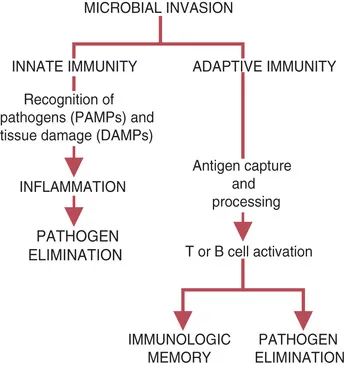
- 552 pages
- English
- ePUB (mobile friendly)
- Available on iOS & Android
About this book
**Selected for Doody's Core Titles® 2024 in Veterinary Medicine** Exploring the immunologic concerns of both large and small animals, Veterinary Immunology: An Introduction, 10th Edition is the only complete resource on immunology for veterinary practitioners. This new edition has been meticulously updated to continue its trend of incorporating the latest advances and topics in the field. It features a straightforward presentation of basic immunologic principles along with thorough and timely information on the most significant immunologic diseases and responses seen in domestic animals.- Comprehensive coverage clearly explains the general principles of immunology, and provides information on the most significant immunologic diseases and immunologic responses seen in domestic animals and marine mammals.- A wealth of clinical examples show how principles will be experienced and addressed in the clinical setting.- Educator and student resources on Evolve feature an image collection, enhanced animations, flashcards, content updates, and a test bank for instructors.- Improved images clarify new content and enhance your understanding.- NEW! Updated content covers new T cell subpopulations, newly described interleukins; new approaches to cancer immunotherapy; immunology of fish; and new advances in genomics.- NEW! Learning objectives have been added to the beginning of each chapter.- NEW! Chapter on commensal bacterial will address the role of commensal bacteria in veterinary immunology and provide convincing explanations for previously poorly understood phenomena.- NEW! Information on the pathogenesis and treatment of atopic dermatitis has been added to help inform veterinarians who treat pets with dermatologic conditions.- NEW! Revised content on cancer immunology reflects the vast expansion of information that has been uncovered in the past five years.- NEW! Expanded information on the role of nutrition in animal immunity offers a rational basis for examining data of those who claim nutritional benefits.- NEW! Full-color histologic images replace black and white images to more effectively convey concepts.
Frequently asked questions
- Essential is ideal for learners and professionals who enjoy exploring a wide range of subjects. Access the Essential Library with 800,000+ trusted titles and best-sellers across business, personal growth, and the humanities. Includes unlimited reading time and Standard Read Aloud voice.
- Complete: Perfect for advanced learners and researchers needing full, unrestricted access. Unlock 1.4M+ books across hundreds of subjects, including academic and specialized titles. The Complete Plan also includes advanced features like Premium Read Aloud and Research Assistant.
Please note we cannot support devices running on iOS 13 and Android 7 or earlier. Learn more about using the app.
Information
Surviving in a Microbial World
The Microbial World
The Defenders

Table of contents
- Cover image
- Title Page
- Table of Contents
- Copyright
- Dedication
- Preface
- Acknowledgments
- 1 Surviving in a Microbial World
- 2 Innate Immunity
- 3 Humoral Innate Immunity
- 4 Humoral Innate Immunity
- 5 Cellular Innate Immunity
- 6 Cellular Innate Immunity
- 7 Sickness
- 8 How Immune Cells Communicate
- 9 Antigens
- 10 Dendritic Cells and Antigen Processing
- 11 The Major Histocompatibility Complex
- 12 Organs of the Immune System
- 13 Lymphocytes
- 14 Helper T Cells and Their Response to Antigens
- 15 B Cells and Their Response to Antigens
- 16 Antibodies
- 17 How Antigen-Binding Receptors Are Made
- 18 T Cells and the Destruction of Cell-Associated Invaders
- 19 Innate Lymphoid Cells
- 20 Regulation of Adaptive Immunity
- 21 The Microbiota and the Immune System
- 22 Immunity at Body Surfaces
- 23 Immunity in the Fetus and Newborn
- 24 Vaccines and Their Production
- 25 The Use of Vaccines
- 26 Immunity to Bacteria and Fungi
- 27 Immunity to Viruses
- 28 Immunity to Parasites
- 29 Mast Cell and Eosinophil-Mediated Hypersensitivity
- 30 Allergic Diseases
- 31 Red Cell Antigens and Antibody-Mediated Hypersensitivity
- 32 Immune Complexes and Neutrophil-Mediated Hypersensitivity
- 33 T Cell–Mediated Hypersensitivity
- 34 Organ Graft Rejection and Pregnancy
- 35 Cancer Immunology and Immunotherapy
- 36 Autoimmunity
- 37 Organ-Specific Autoimmune Diseases
- 38 Immune-Mediated Inflammatory Diseases
- 39 Primary Immunodeficiencies
- 40 Secondary Immunological Defects
- 41 Drugs and Other Agents That Affect the Immune System
- 42 Immunodiagnostic Techniques
- 43 Evolution of the Immune System
- Appendix 1 Annotated List of Selected CD Molecules
- Appendix 2 Some Selected Cytokines
- Appendix 3 Some Important Abbreviations
- Glossary
- Index
- Greek Letters